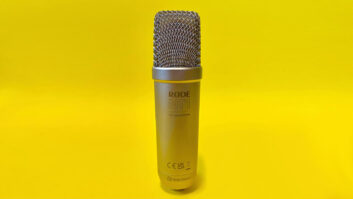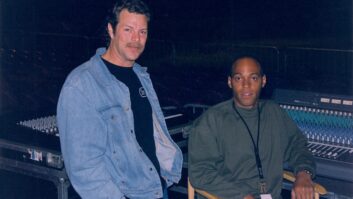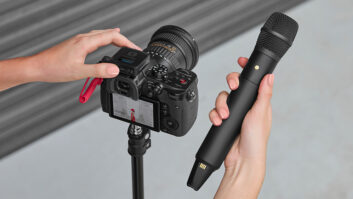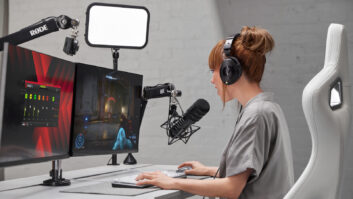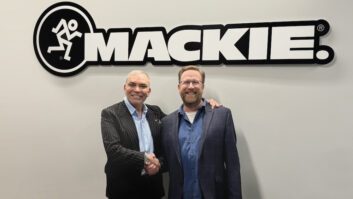When I mentioned that I was reviewing the RØDE NT1 mic to my local pro audio dealer (Hi Garth!), he told me they were hard to sell because the price was too low! Evidently, most people are thrown off by the $499 price tag, but do not be deceived; this is a great mic.
The NT1 has a friendly, vintage look. The low-noise, transformerless circuitry is internally shock-mounted in a machined aluminum shell with a light gray enamel finish. It feels solid in the hand but is amazingly light (320 grams) and well-balanced. The grille has two different densities of mesh: The first layer is an open weave, and the second layer is made of a fine steel fabric. This assembly forms a rugged transducer cover that is acoustically transparent but physically strong.
The mic comes in a rugged plastic case with foam lining and a packet of silica crystals for moisture absorption. The manual warns that the diaphragm (as with most condenser mics) dislikes moisture. When I received the mic, the crystals were pink, indicating that they were full of moisture. I dried the packet to a nice blue color, but when they were returned to the mic case, they turned pink within an hour. Perhaps my Seattle studio is ultra-damp, or maybe the mic itself had a fair amount of moisture in it. The mystery remains.
My first opportunity to use the NT1 was on a CD editing session with Eyvind Kang. As an old Kimball piano had been delivered to the studio just days before, Eyvind suggested adding a piano track to the project. Six seconds after phantom power was applied, the NT1 stabilized and I was hit with amazingly accurate sound. The sound was so stunning that I ran out to the studio to see if the piano actually sounded that way of its own design or if the mic was able to make an old, beaten instrument sound more beautiful. Fortunately, the Kimball actually sounded good of its own accord.
The manual suggests the use of an external pop filter, stating that plosives might bottom out the capsule. Indeed, I found that just a steady blowing toward the capsule bottomed it out. The ol’ pencil trick reduced the plosive effect, but an external wind screen would probably be required on an up-close and personal vocal.
Accuracy is the operative word here, so I subsequently tested the NT1 on cello, contrabass, vocals, violin, trumpet, acoustic guitar, hand percussion, electric guitar, various odd sound makers and drum kit, and was impressed with the mic’s ability to capture what I was hearing. On each instrument tested, the musician was asked to evaluate the sound of the test recording, and in each case the artists were pleased with the sound of their instruments—so much so that several commented that their instruments had never sounded better.
The cello and acoustic guitar tests were particularly stunning. I felt that a single NT1 produced 3-D recordings. The cello recording possessed extreme depth, and the acoustic guitar seemed to jump out of the speakers.
I was curious about using the NT1 for stereo. During this test, I discovered a key to its sound: The NT1 is a true large-diaphragm condenser mic with a single 1-inch, gold-sputtered diaphragm. This single diaphragm creates a semi-cardioid pickup pattern that resembles a deranged figure-8. It picks up beautifully in front, to a lesser degree on the sides and quite well in the back.
As a stereo pair, two NT1’s work well together. I’ve found that a pronounced stereo recording can be made with the capsules forming a 90-degree angle with the front facing out. It works well because of the “blind” spot on the sides of the mic. If you face the capsules toward each other, the image is not as wide (obviously), but the “blind” spots on the mic’s sides punch holes in the stereo image.
Although the mic boasts a 135dB maximum SPL spec, the NT1 failed to capture the sound of a Super Deluxe and Telecaster combo without overload. Too loud, I guess. Nor does it like to be an overhead on a drum kit (although it sounds great at 20 feet away). Use the pad switch on your preamp for the loud stuff, but I think I’ll reserve these mics for the quieter instruments and vocal passages.
Overall, the RØDE NT1 is a real workhorse, sounds good on just about everything, and is relatively inexpensive. Personally, I could use 10 of them!
RØDE Microphones, www.rodemics.com

